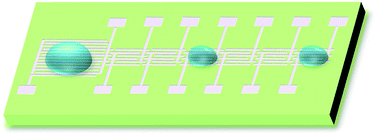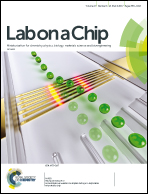Dielectrowetting manipulation for digital microfluidics: creating, transporting, splitting, and merging of droplets†
Abstract
Generating, splitting, transporting, and merging droplets are fundamental and critical unit operations for digital (droplet-based) microfluidics. State-of-the-art digital microfluidics performs such operations commonly using electrowetting-on-dielectric (EWOD) in the typical configuration of two parallel channel plates. This paper presents such operations using dielectrowetting (derived from liquid dielectrophoresis), not EWOD, with an array of interdigitated electrodes. The major and unique feature is that the present droplet manipulations are effective for conductive (water with/without surfactant) and non-conductive (propylene carbonate) fluids. An equally important aspect is that the manipulations are performed in an open space without the covering top plate. This behavior is attributed to the intrinsic nature of dielectrowetting to generate stronger wetting forces than EWOD (with the ability to achieve complete wetting with contact angle = 0° to form a thin film). Using dielectrowetting, micro-droplets of various volumes are created from a large droplet and transported. Splitting a single droplet as well as multiple droplets and merging them are also achieved, even when the droplets are smaller than the electrode pads. The above splitting, transport, and merging operations are effective for propylene carbonate as well as DI water with/without surfactant, though the creating operation is proven only for propylene carbonate at this moment. All the above manipulations are successfully carried out on a single plate, which not only simplifies the structure and operation procedure, but could also eliminate the restriction to the volume of fluid handled.



 Please wait while we load your content...
Please wait while we load your content...